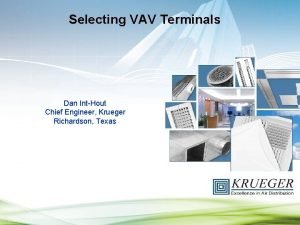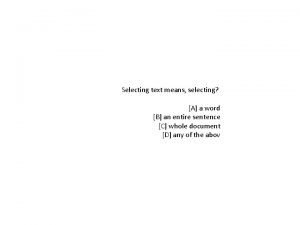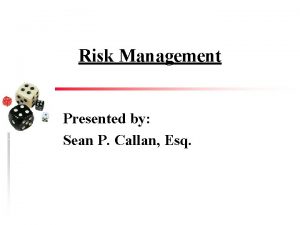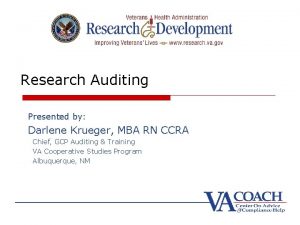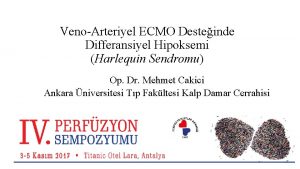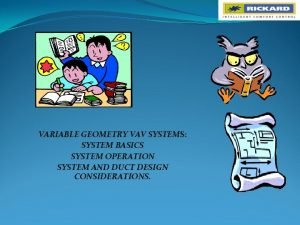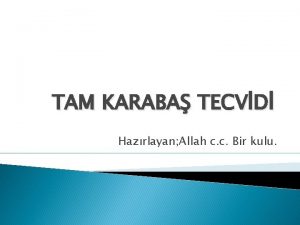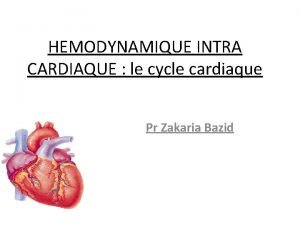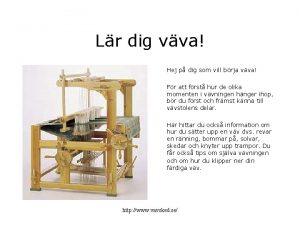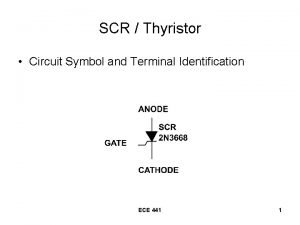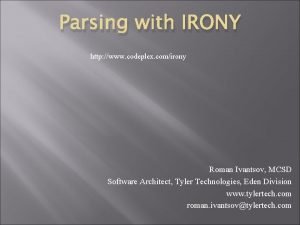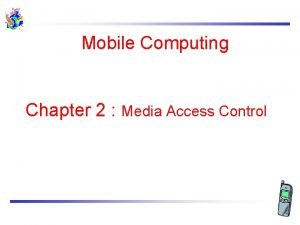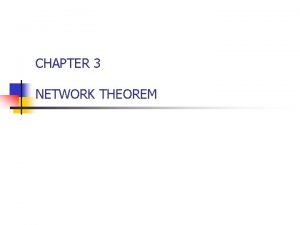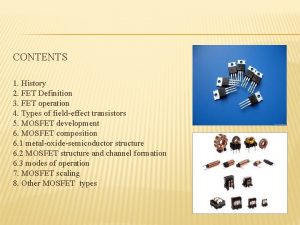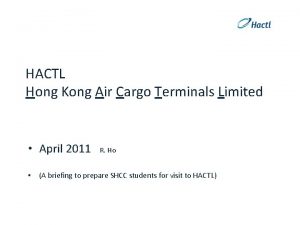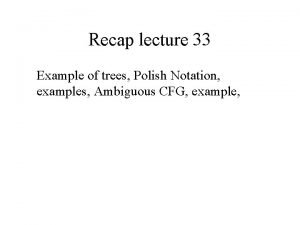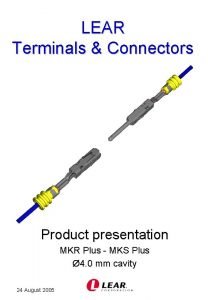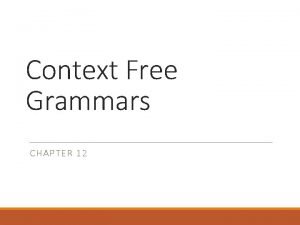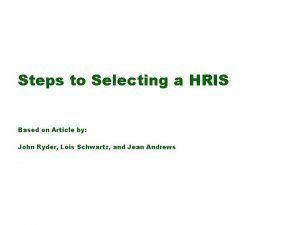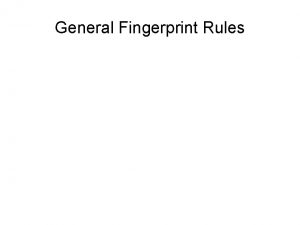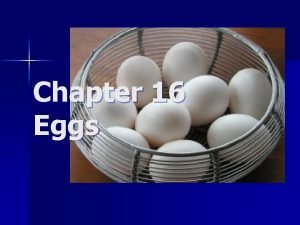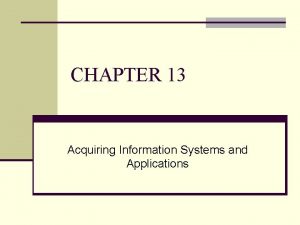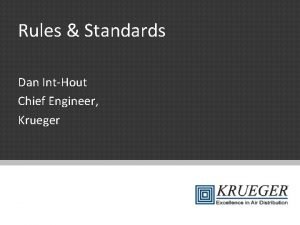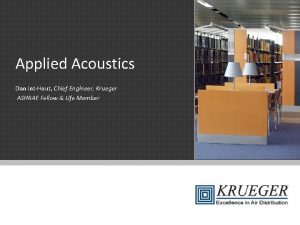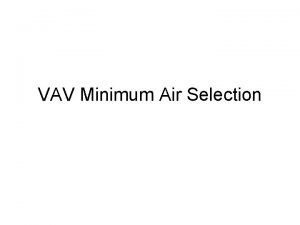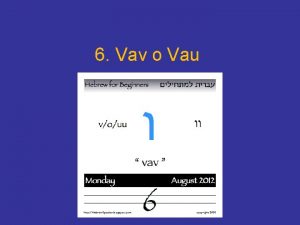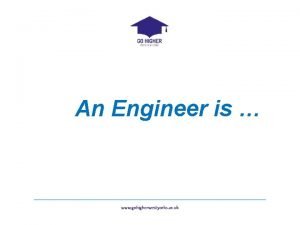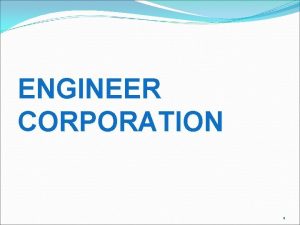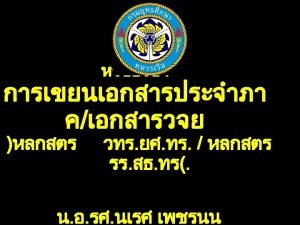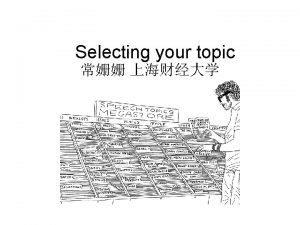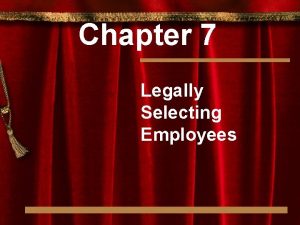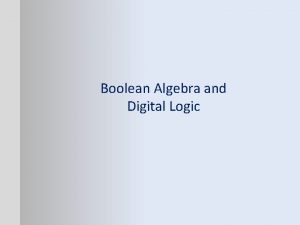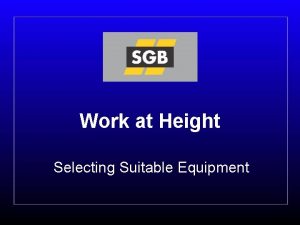Selecting VAV Terminals Dan IntHout Chief Engineer Krueger









































- Slides: 41

Selecting VAV Terminals Dan Int-Hout Chief Engineer, Krueger Richardson, Texas

Terminal Units • Single Duct • Retro-Fit Dampers • Bypass Dampers • Dual Duct • Parallel Fan Powered • Series Fan Powered

The Construction Specifier, July ‘ 04

Single Duct Terminal Units

When to Use Single Duct Terminals Standard Single Duct • Interior spaces – Where only cooling is required. Heating not needed due to climate and heating from perimeter areas. • Perimeter with reheat – Cooling along outer walls with some small reheat on the coldest days. • Interior with reheat to maintain ventilation minimums – Only cooling is required but reheating for minimum airflows • Supply return tracking – Airflow measurement and control into and out of a laboratory space.

Retro-Fit Single Duct Terminals • Retrofitting old terminal units. – Mechanical constant volume dual duct dampers for high pressure systems replaced with round units for measuring and controlling airflow. • Adding a control zone. – Round units added to a round duct or square ones to a square duct to measure and control airflow in a new occupied zone monitored with T’stat. • Round Retro-Fit Replacing VVT-type zone dampers – replace existing high pressure, high velocity zone controlled units with low pressure VAV units. • As a return damper – Added to existing ductwork to measure and control leaving airflow as required from controls. Square Slip In Retro-Fit

Dual Duct Terminal Units

When to Use Dual Duct Terminals • Perimeter Heating & Cooling • Positive ventilation control (measured ventilation to the zone) • Laboratories / Constant volume applications • Supply / Return tracking • Underfloor Air Conditioning • Be sure you understand the mixing / control requirements • Upstream vs. downstream flow sensing issues

Non-Mixing Dual Duct l l 2 Single No Mixing duct units Two single duct Units Joined S&D Discharge Inlet Sensing Only Joining Strip Standard Dual Duct

Mixing Dual Duct l l l Attenuated Dual Duct May have inlet or total flow discharge sensing Unequal inlet size combinations are available Many types of linings are available Mixing baffle can have up to 20: 1 Mixing Ratio. Typically have high minimum inlet pressure requirement Premium Dual Duct

Opportunities for Dual Duct Systems • Dual Duct can meet the most stringent requirements for classroom acoustics, as well as 90. 1 requirements. • Providing 100 OA (DOAS? ) through one inlet allows validation of ventilation rates • Supplemental heating and even sensible cooling coils are being considered in some designs.

Fan Powered Terminal Units

When to use fan powered terminals • Originally designed for perimeter heating and cooling - to avoid reheat • Constant volume applications have a fan near the discharge - series boxes • Series Boxes provide relatively constant interior sound levels and air flow rates and are often used in interior zones. • Because of energy concerns, the ECM motor has been employed in many applications. • Texas A&M recently completed a study, donated to ASHRAE and AHRI at the summer meeting in Montreal, on Series vs. Parallel, and ECM vs PSC motors. • The data is being used to update HAP, TRACE and Equest energy calculation software

ECM Motors • • • The use of ECM motors can reduce the true energy consumption of Fan Powered Terminals An ECM motor is a brushless DC motor, with an integral computer controlled inverter. At typical rpm and load, an ECM motor can use as little as 60% of the watts of a standard Permanent Split / Capacitor Start (PSC) motor. When used in a VAV Series application, it can use as little as 10% of a CV PSC motor. An ECM motor is almost always programmed to be pressure independent, resulting in true constant volume performance, easier balancing, and DDC-VAV controlled performance. (+/- 5%)

ECM Motors Some Cautions, however: • An ECM motor can add significantly to the purchase price of a Fan Powered Terminal. • Power consumption CAN be greater than an equivalent PSC motor, and the connected load requirement is usually higher because of this. • There are issues with the power factor of these types of devices which may cloud true energy savings.

Series Fan Boxes SERIES FAN POWERED BOXES • May be constant or (with ECM motors) VAV air flow. • Fan is on discharge of unit - all air goes through the fan (primary airflow cannot exceed fan airflow) • Fan runs at all times during occupancy • With PSC motors, the fan must be started before primary air is supplied. • Note: there is no such thing as an “antibackward rotation device”. • Radiated sound is critical sound application factor.

Parallel Fan Boxes PARALLEL FAN POWERED BOXES • • • Fan is in parallel with VAV damper Fan airflow independent of primary airflow Fan is essentially first stage of heat Backdraft damper is standard, but seldom less than 10% leakage. Discharge sound is critical application factor

Texas A&M Study Results • System energy use was measured for PSC and ECM motors, series and parallel designs. • Data was generated for entire building systems, not just terminals. • Parameters were developed for detailed full building energy analysis • Results have been presented in over 20 ASHRAE Papers, and full study results have been donated to ASHRAE and AHRI. • Three Journal articles are being written for this summer.

Texas A&M Study Results • The results showed that both system operation and climate had a great effect on final energy use. • In general, however there were a few important observations: § § – With Parallel boxes, ECM and PSC motors had the same building energy consumption – Parallel boxes could be more efficient than series boxes, except for back-draft damper leakage, which was found to be very significant. – Series boxes at constant volume, with ECM motors, are the most energy efficient choice, (at least until someone develops a leak proof parallel box). – Series Boxes, with DDC system variable volume fan flow, are likely more efficient than any other air distribution method, at low part load operation. AHRI has an active project to get the data input into Carrier’s HAP and Trane’s TRACE programs so proper energy calculations can be made. DOE is dragging their feet in updating Energy Plus is incredibly inaccurate is estimating energy use of fan powered terminals, overestimating energy use by orders of magnitude.

Electric Reheat Options • • • 120/208/240/277 single phase 208/3 phase (3 -wire), 480/3 phase (4 -wire) 1 -3 Stages (most types) Side access - Leave clearance per NEC Operation at minimum airflow is unlikely to provide comfort Consider proportional electric heat with discharge temperature control for maximum comfort

Proportional Electric Reheat There are two types of proportional electric heat: • SCR Electric Heat – Requires analog input – Somewhat expensive • Time Proportional Electric Heat – – – 1 Stage only required Infinite adjustment Low cost Silent Allows for effective discharge temperature control Many different control inputs

RP 1515 • ASHRAE sponsored a research project in California a couple years ago. • Subject was the Yahoo campus (1 m sq. ft. ) and a couple other buildings • They measured occupant satisfaction, equipment operation, environmental variables and energy use. • Yahoo System was DDC Single Duct VAV reheat. • Interior airflow was set a 1 cfm/sf, 30% turn down • Diffusers were plaque type.

RP 1515 Observations • Initial Occupant satisfaction was low, below 40% • Boilers were operating in summer (only use for boilers was reheat coils) • Space temperatures were 68 F by late afternoon, while set at 73 F • California code requires 5 degree dead band, so units went into heating mode and controlled to 68 F the rest of the day.

RP 1515 Diagnostics • • At 30% of max interior airflow, space was sub cooled. Space was maintained at 68 F till end of day. After analysis, VAV boxes were reset to 10% (0. 1 cfm/sf) System settled at 0. 22 cfm/sf (= minimum ventilation rate per Title 24) • Occupant satisfaction soared as space maintained 73 F • Boilers shut down.

RP 1515 Conclusions • Interior loads are far less than 1 cfm/sf (the national average). • Occupant satisfaction above 80% can be achieved at 0. 22 cfm/sf (with good diffusers) “There is no mimumum air speed for comfort” : Standard 55” • Interior loads are close to 100% outside air, meaning 100% of interior loads are exhausted from the building, not returned to air handler. • The load in the building is controlled where outside air is introduced into the building, not by equipment in the zone. • PS: This is Huge!

Minimum Ventilation Rate • ASHRAE Standard 62. 1 defines three rates: – Off (not Occupied) – Unoccupied (0. 05 cfm/sf) – Occupied Sum of Unoccupied plus cfm/person • So there is not one, but several requirements in any building. • Any could exist at any time, implying a variable flow zone control is required for the ventilation system

Washington State Code • As of Nov 1, in Washington State, Large Commercial buildings are required to directly supply ventilation air to every space. • This means a mixing air handler is not allowed, essentially outlawing VAV. • The exception is a “High Performance Air Distribution Systems (HPAS)”, although not clearly defined. • Series Fan Terminals are allowed if the fan is “load following”. • AMCA has published a “white paper”. • I did a webinar on last May.

Advantages to Ventilation Many studies have been presented showing that increased ventilation: • Increase Student Test Scores • Reduced employee absenteeism • Increases productivity Economizer operation is extremely effective in reducing cost while increasing mean ventilation rates.

DOAS Implications • Ventilation Rates are Not Constant • Design Ventilation rate into a zone is currently required to be measurable • Washington Code Requires it to be separately delivered and controlled • Varying ventilation rates implies the need for a pressure independent VAV-type delivery system for all system types.

• Fresh Air Terminal Unit • • • Outside air can be supplied to a Series Fan Terminal through a second ducted system. This requires two duct systems, but separates ventilation and recirculated air. The system allows monitoring of ventilation rates into each zone. • A stand-alone Pressure Independent controller on the DOAS inlet, tied to the fan relay, will allow standard DDC zone controls. • Primary Inlet • Induced Air Inlet • Fresh Air Inlet • Series Fan Powered Terminal Unit

The Chilled Box Sensible Cooling Coil Optional MERV 8 Filter Standard Ceiling Diffusers Dedicated Outdoor Air Supply Series ECM Fan Powered Terminal Unit Standard Reheat Options

Chilled Fan Powered Terminal Unit • 100% Outside air can be supplied to a Series Fan Terminal through a ducted system, designed to handle ventilation and latent loads. • A sensible cooling coil, on the induced air inlet, cools plenum air for additional sensible space cooling. • The system allows monitoring of ventilation rates into each zone. • Both Series and Parallel designs are currently being used depending on the installation. • Many buildings are now in operation with this type of system (Including the Pentagon) so pre-programmed controllers are available from several vendors. Sensible cooling coil Induced Air Inlet DOAS Air Inlet ECM Fan Powered Terminal Unit

VAV Series Flow Chilled Box Control Strategies • Take advantage of the ECM Variable Volume capability, maintaining as low a total flow as necessary (but always greater than primary inlet air flow rate). • DOAS Ventilation air should typically be as cold and dry as possible. • Increase fan CFM slightly to bring in warm plenum air as required to avoid sub cooling while maintaining ventilation rates and humidity control. • Increase primary (ventilation) air during periods of high perimeter cooling demand. • Run in economizer mode whenever possible

Economizer • Economizer operation results in huge energy savings. • By slightly oversizing the ductwork and inlets to the chilled boxes, effective economizer operation can be achieved over a broad range of conditions. • If outside air dew points are low enough, the sensible coils can extend this range.

Chilled Box with Chilled Beams Perimeter Slot Diffusers Series DOAS Unit Discharge Heating Coil DOAS Air Supply Interior Chilled Beam’s

Chilled Parallel Unit Supplying Chilled Beams Secondary DOAS Duct Parallel DOAS Unit Active Chilled Beams Dedicated Outdoor Air Duct

Chilled Box Summary • • • Low first cost Low system pressure requirement Easily reconfigurable Minimal Contractor Training Guaranteed Performance Several LEED points possible

Summary • LEED and IMC 2009 (and later) require meeting Standard 62. 1 VRP. • Acoustics should be specified on the basis of need with clear assumptions. Use AHRI 885 • Reheat needs to be carefully considered in terms of discharge temperatures and velocities. • Software is available to assist in selecting the best mix of products. • The rules are dynamic - pay attention.

Engineer’s Checklist • Are Specifications current? l l If specified clearly, you may get what you want! If unclear, you will get what the low bidder wants you to get. – Real Manufacturers – Current Standards referenced • Do we have clear acoustical requirements: – Inlet Ps defined? – Assumptions clearly defined? • Reheat: – Sufficient airflow? Discharge Static? – 3 or 4 wire 480 V? Contactors? Stages? – gpm or btuh? (pick one) • Linings – are acoustics and cost understood? • Accessories – – – Transformers? Filters? Hanger brackets? Fuses, Disconnects?

ANY QUESTIONS?

Contact dint-hout@krueger-hvac. com www. krueger-hvac. com
 Krueger vav
Krueger vav Vav hei vav
Vav hei vav Selecting text means selecting
Selecting text means selecting Chief engineer of the union pacific railroad
Chief engineer of the union pacific railroad Engine room watchkeeping checklist
Engine room watchkeeping checklist Lesson 3 commander in chief and chief diplomat
Lesson 3 commander in chief and chief diplomat Scott krueger
Scott krueger Anita krueger md
Anita krueger md Norris krueger
Norris krueger Darlene krueger
Darlene krueger Vav bot discord
Vav bot discord Harlequin sendromu
Harlequin sendromu Equal friction method
Equal friction method Izhar harfleri
Izhar harfleri Ecmo vav
Ecmo vav Systole et diastole
Systole et diastole Insan vav şeklinde doğar
Insan vav şeklinde doğar Pärlknut
Pärlknut Terminal in scr
Terminal in scr Irony parser
Irony parser Csma in mobile computing
Csma in mobile computing High power terminals
High power terminals Apm terminals headquarters
Apm terminals headquarters How to identify transistor terminals
How to identify transistor terminals Norton's equivalent
Norton's equivalent A mosfet has …………… terminals *
A mosfet has …………… terminals * Jfet terminals identification
Jfet terminals identification Hactl hong kong
Hactl hong kong A semiword is a string of terminals
A semiword is a string of terminals Lear connectors
Lear connectors A semiword is a string of terminals
A semiword is a string of terminals Hris selection criteria
Hris selection criteria Investment risk example
Investment risk example Squint test in complete denture
Squint test in complete denture The logical view of a database:
The logical view of a database: Recruiting for international assignments
Recruiting for international assignments Rules of selecting delta and core
Rules of selecting delta and core Chapter 9 driving in urban traffic answers
Chapter 9 driving in urban traffic answers Potential development projects can be identified by
Potential development projects can be identified by Selecting investment in global market
Selecting investment in global market Chapter 18 eggs selecting and storing eggs
Chapter 18 eggs selecting and storing eggs Acquiring information systems and applications
Acquiring information systems and applications
